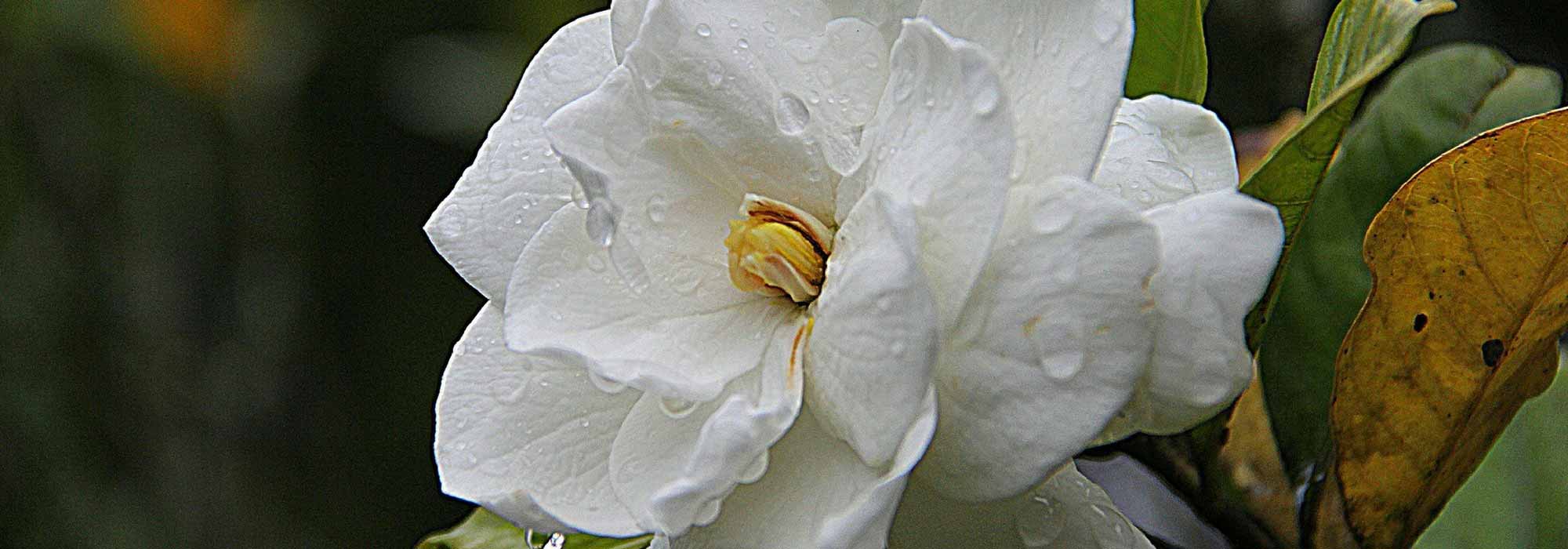
Gardenia: planting, care, pruning, watering
Contents
Gardenia in a nutshell
- Gardenia is one of the most divinely scented flowers in the plant world
- With its beautiful evergreen foliage, Gardenia remains stunning even in winter when other plants are dormant
- Hardy down to -10° C for some varieties, it is a tender bush that can only be grown outdoors in mild regions
- Quite delicate to cultivate, it is one of those bushes that require perfect conditions to thrive
- It grows in fertile, acidic, cool, and well-drained soil and enjoys humid atmospheres
A word from our expert
If the Gardenia or “gardenia of the gardens” is an indoor bush adored for its fragrant white flowers, it is also a sumptuous plant whose some varieties are capable of surviving outdoors in mild regions. However, it is difficult to consider growing this bush in all corners of France, as mild and humid climates are its preference.
Fortunately, in recent years, more hardy and cold-resistant gardenias have emerged and are beginning to find their way into our gardens, such as the Gardenia ‘Crown Jewel’. These gardenias offer the possibility of being grown in the ground as well as in pots, for a remarkable and long-lasting effect.
If its addictive, intense and voluptuous jasmine scent has inspired a novel “The Red Gardenia” and an iconic perfume from a very famous perfumer, the flowering of the gardenia remains invariably white to cream-white and spreads from May to October.
Its graphic, glossy dark green foliage provides a touch of greenery all year round, punctuated by numerous bouquets of fragrant flowers from late spring onwards.
With a rather delicate cultivation, it will show gratitude and be accommodating in fertile soil, ideally in heather soil, cool but well-drained, where it will grow sheltered from cold winds and stagnant moisture.
The gardenia is one of the most sought-after bushes by lovers of beautiful plants, a true treasure for the garden or terrace.
Discover the most beautiful outdoor gardenias and let yourself be seduced by this sophisticated, highly fragrant and floriferous bush.
Description and Botany
Botanical data
- Latin name Gardenia
- Family Rubiaceae
- Common name Gardenia
- Flowering from May to September
- Height 0.60 to 2 m
- Exposure Sun, partial shade
- Soil type Neutral, acidic, well-drained
- Hardiness -10°C
The Gardenia is a bush from the Rubiaceae family, native to Asia and South Africa. It is frequently found in the wild, at the edges of subtropical to tropical forests. The genus comprises around 200 bushy and evergreen species, but only Gardenia augusta (synonymous with G. florida, G. grandiflora, and G. jasminoides, the most common species with an intoxicating jasmine fragrance) and its numerous American cultivars are commonly cultivated in our latitudes. Occasionally, Gardenia thunbergia can be found, which can grow up to 5 m and has spiralled flowers.
It slowly forms a small bush with greyish bark and a bushy, flexible, and graceful habit, measuring between 60 cm and 2 m in height in our gardens but can reach up to 12 m in its natural habitat for some rare species. The Gardenia has a very long lifespan.
On fairly flexible branches, it blooms with rare elegance, producing foliage that is most often a glossy dark green and waxy. Sometimes it is streaked with white (‘Veitchiana’). With oval, elliptical, or lanceolate shapes, the leaves, measuring 5 to 15 cm long, are opposite or inserted along the axis around the stem, in whorls of three or more. Entire, thick, leathery, evergreen, with very prominent veins, sometimes slightly undulate, they provide a lush and permanent green backdrop against which the flowers stand out.
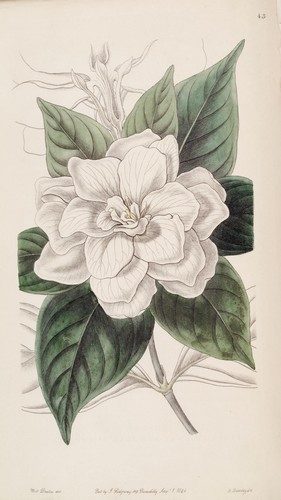
Gardenia jasminoides – botanical illustration
Its sumptuous and very spreading flowering throughout the summer, with a floral scent that is delightfully intoxicating, is its main asset. From May to September, pure white to ivory cup-shaped flowers appear, most often solitary or gathered in small cymes at the axil of the leaves, at the top or along the branches. If conditions allow, some gardenias like ‘Veitchiana’ can continue to bloom in winter, from January to March.
With a waxy texture, each flower opens into a silky corolla of 5 to 12 lobed petals, spreading and measuring 4 to 8 m in diameter. They can be single (Gardenia ‘Kleim’s Hardy’), semi-double (Gardenia jasminoides ‘Summer Snow’), or double (Gardenia jasminoides ‘Crown Jewel’). The Gardenia thunbergia has tubular flowers with spirally imbricate petals.
They exude a floral jasmine scent, intense and voluptuous.
This evergreen bush is planted in the ground, in partial shade, sheltered from the scorching sun and draughts. Quite demanding, it only thrives in acidic soil, free from lime, fresh, fertile, light, and well-drained, as well as in humid atmospheres. Of all climates, it prefers the mild oceanic climate that is well-watered.
There are now quite hardy gardenias, (down to -10°C to -12°C maximum in well-drained soil), capable of surviving in the ground during our not too harsh winters. In colder regions, the gardenia will be grown in large pots to be stored in winter, protected from severe frosts, like orange trees in an unheated conservatory or a cold greenhouse.

Evolution of a flower of Gardenia jasminoides.
Read also
Planting Perennials and BushesMain species and varieties
Il existe de nombreuses species and varieties of gardenias but only Gardenia jasminoides, the Cape Jasmine (synonym Gardenia augusta, G. florid, G. grandiflora) with its intoxicating jasmine fragrance and numerous American cultivars are commonly grown in our gardens. In recent years, hardier hybrid gardenias (-10°C to -15°C), such as ‘Kleim’s Hardy’ or ‘Crown Jewel’ have emerged, making it possible to grow gardenias outdoors, in the ground in our mild climate gardens.
The most popular

Gardenia jasminoides Kleims Hardy
- Flowering time June to November
- Height at maturity 80 cm
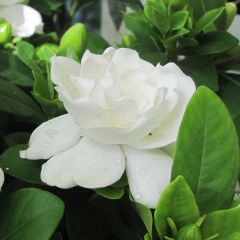
Gardenia jasminoides Crown Jewel - Cape Jasmine
- Flowering time June to October
- Height at maturity 1 m
Our favourites
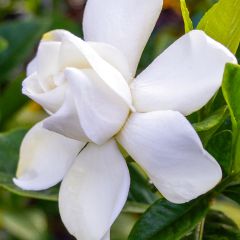
Gardenia jasminoides Summer Snow
- Flowering time June to August
- Height at maturity 1,10 m
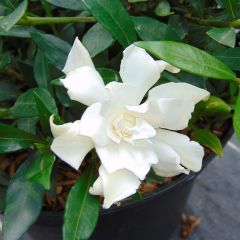
Gardenia jasminoides Perfumed Petticoats
- Flowering time June to October
- Height at maturity 75 cm
Discover other Gardenia
View all →Available in 1 sizes
Available in 1 sizes
Available in 1 sizes
Available in 1 sizes
Available in 1 sizes
Available in 2 sizes
Available in 1 sizes
Available in 1 sizes
Available in 1 sizes
Available in 1 sizes
Planting
Where to plant a gardenia?
Cultivating a gardenia is not always straightforward; it is better to respect its rather delicate nature. It is entirely possible to grow a gardenia in the ground, but only in regions where frost is very rare. It has a clear preference for warm climates in summer and mild, humid conditions in winter (from Southern Brittany to Biarritz) as it does not withstand frost.
Like the camellia, with which it shares similar requirements, this rather tender bush will still endure light frosts of short duration down to about -12°C (sometimes more) but only south of the Loire, in very well-drained soil and in a location well sheltered from draughts. The hardiness of the gardenia varies depending on the duration of the frosts and the moisture content of the soil. Elsewhere, it is preferable to grow it in a pot, which should be stored in a cold greenhouse during winter.
Plant it out of the cold, drying winds to increase its hardiness and help it cope better with frost. Position the gardenia in a semi-shaded bed or exposed to morning sun, sheltered from the scorching sun that could damage its foliage and flower buds. However, it does need plenty of light to bloom well, but avoid direct sunlight during the hottest hours.
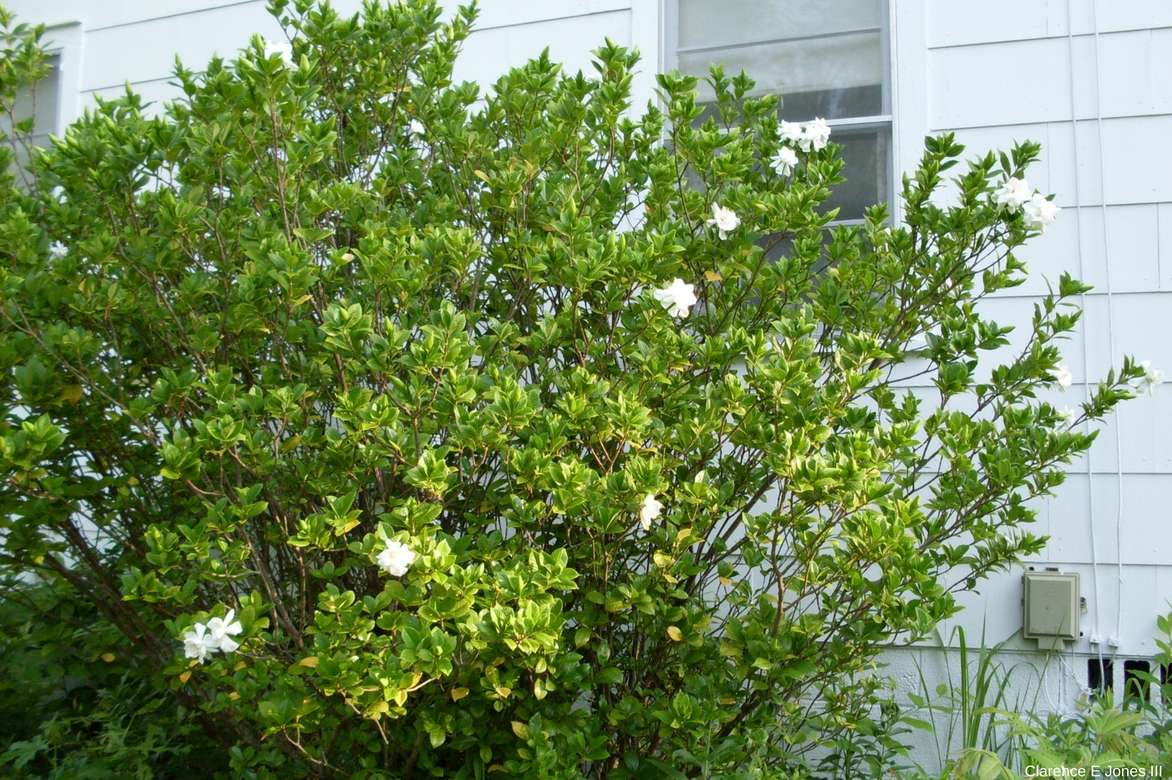
Plant your gardenia out of the cold winds, against a well-exposed wall, on the east side, for example.
It prefers a fertile, acidic, and well-drained soil that remains cool in summer. It does not tolerate limestone well, so plant it alongside ericaceous plants. It does not tolerate dry environments as well as excess moisture, especially in winter, which would surely rot its roots. While it copes well with heat, it should be watered regularly during heatwaves to maintain its humid environment.
In the garden, it is perfect when planted under large deciduous trees: these provide the shade and drainage that the gardenia loves. It will thrive even better, protected by a wall or a hedge. It rarely exceeds 1.5 m in height when mature, making it a must-have in small gardens. The gardenia pairs well with other ericaceous plants such as hydrangeas, pieris, kalmias, and rhododendrons.
This delightfully fragrant bush deserves a special place on the terrace, not far from the house near a frequently used path, where it will fill the air with its sweet flowering.
When to plant a gardenia?
The gardenia should be planted in the ground, ideally in spring, in May, when the risk of frost has passed. Planting in autumn from September to November, after the heat has subsided, is also possible.
How to plant the gardenia?
In the ground
The gardenia needs a draining substrate that is rich in humus. Provide it with deep, light soil, acidified with an addition of heather soil and a bit of river sand, coarse gravel, or clay balls to lighten it. Plant it in groups of 2 or 3 per m² for a beautiful effect in a bed. A single plant can create a lovely mass effect, especially if mixed with other evergreen foliage. When mixed with other shrubs, space them only 50 cm apart. It requires good drainage (its roots do not like stagnant moisture) of about twenty centimetres at the bottom of the planting hole.
- Soak the root ball in a bucket for a few minutes
- Loosen the soil to about 25-30 cm deep
- Dig a hole 3 to 5 times wider than the root ball
- Add a good amount of pumice, turf, and gravel at the bottom of the hole
- Plant the shrub at collar level
- Amend the soil with heather soil, dried leaves, or river sand.
- Fill the hole, compact it, then water generously at planting and whenever the soil is dry throughout the growing season
Growing the gardenia in a pot
In a pot, it does not appreciate overly dry, confined atmospheres: ensure to maintain a good level of ambient humidity and do not place it near a radiator or in direct sunlight. The gardenia loves greenhouses or warm conservatories between 12 and 18°C, but can be taken out onto the terrace in good weather, sheltered from draughts.
- Plant it in a mixture of heather soil combined with good potting soil for houseplants and leaf mould
- Place clay balls at the bottom of the pot
- Set the pot on a bed of clay balls submerged in water
- Position it in a bright place out of direct sunlight
→ Learn more about the planting and care of gardenia in pots in our advice sheet.
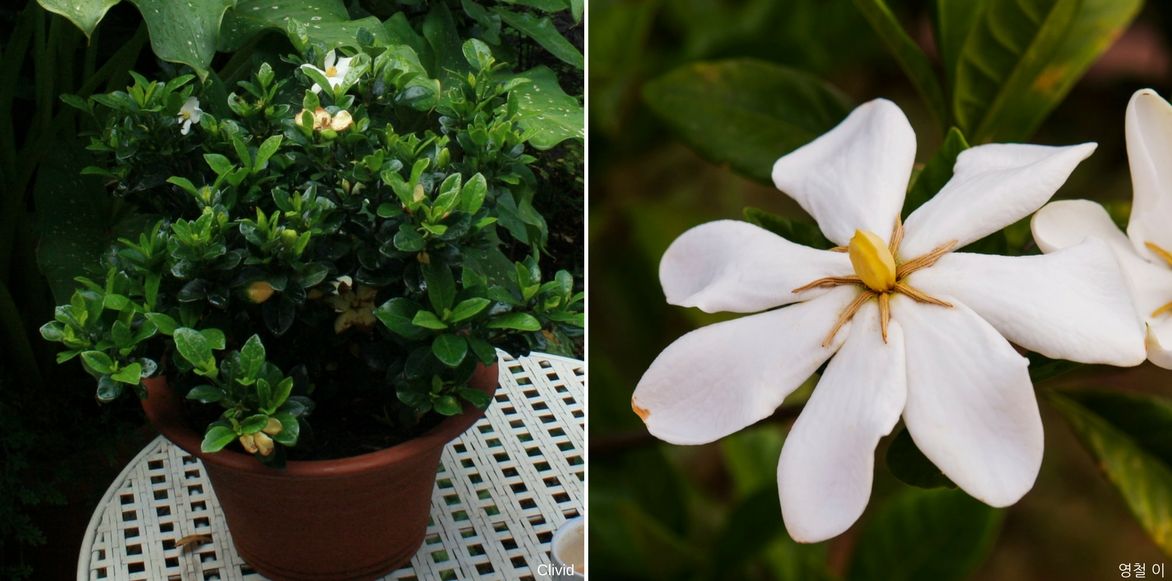
Gardenia jasminoides ‘Kleim’s Hardy’ grown in a pot.
Read also
Plant young ericaceous plantsPruning and care
It is a bush that offers, each year, from spring to the end of summer, an abundant flowering… provided you give it a little attention and provide it with suitable care. In a pot or in the ground, the gardenia needs a very high ambient humidity level to thrive.
In the ground
Only water with rainwater (it hates lime), without flooding the plant. Shower the foliage during hot weather but avoid wetting the flowers as this discolours the flowers and causes spots on the foliage.
Each year, in spring and autumn, spread a good layer of organic mulch (bark or pine needles, leaf litter) to keep its roots cool in summer and warm during winter.
In case of severe frost forecast, cover the aerial parts with a winter fleece.
In winter, reduce watering to about once a week.
It requires regular fertilisation to support its flowering: in summer, every two weeks, apply acid fertiliser for gardenias, specific for heather soil shrubs. You can incorporate a little compost by superficial scratching around the base every year or every two years, or a special heather soil fertiliser.
Gardenia in a pot
Water in summer, once or twice a week with rainwater or spring water. Allow the soil to dry out between waterings. Place the pot in light without direct sunlight and away from a radiator, on a saucer of clay balls or gravel soaked in water. In winter, watering every 15 days is sufficient. Provide an acid liquid fertiliser for gardenias once a month.
In cold regions, take it outside during the fine season and bring it in to protect it from frost, in a greenhouse or conservatory for winter.
Each year, perform a top dressing in spring with a mixture of potting soil and heather soil. A repotting at the end of winter or the beginning of spring, every 2 to 3 years is necessary for the plant to thrive: repot in a mixture of potting soil and heather soil or in a special gardenia potting mix.
Pruning the gardenia
Pruning the gardenia is useful after flowering to maintain a beautiful harmonious and compact shape.
- Lightly prune (1/3) the stems compromising symmetry
- Remove dead wood
- Remove faded flowers to prevent exhausting the bush and thus encourage beautiful flowering the following year
Diseases and potential pests
A gardenia grown indoors will be more susceptible to diseases and attacks from parasitic insects. In open ground, frost and excess water in winter are the main enemies of this tender bush.
Aphids, mealybugs, and grey mould are the primary foes of Gardenia.

Colony of aphids and some mealybugs on a leaf of Gardenia.
In case of an aphid attack, eliminate the colonies by spraying the plant with water or washing the foliage with soapy water.
Make rapeseed oil sprays to suffocate the mealybugs.
Absolutely avoid hard water which causes the foliage to yellow and promotes the appearance of chlorosis.
Sometimes the flowers fall before they even bloom, which is likely due to a lack of moisture: mist non-hard water on the leaves.
→ Also read our advice sheet: Diseases and pests of Gardenia.
Multiplication
It is quite possible to propagate a gardenia by propagation by cuttings in early spring.
- Take cuttings of about 8-10 cm
- Remove the lower leaves, leaving only the upper pair
- Dip the cutting in plant hormone.
- Plant the stem cuttings in pots filled with a moist mixture of turf and river sand
- Place the cuttings in a warm spot (18 – 20 °C) with light, avoiding direct sunlight and ensuring a high humidity level
- Keep the substrate slightly moist until rooting, which takes about a month
- Plant the young plants in the garden the following spring
Associate
Gardenia is the star of shaded gardens, bringing light and sophistication with its profusion of delicate flowers. In vibrant punctuation or mixed with other bushes, in a mild climate, it easily integrates into any decor.
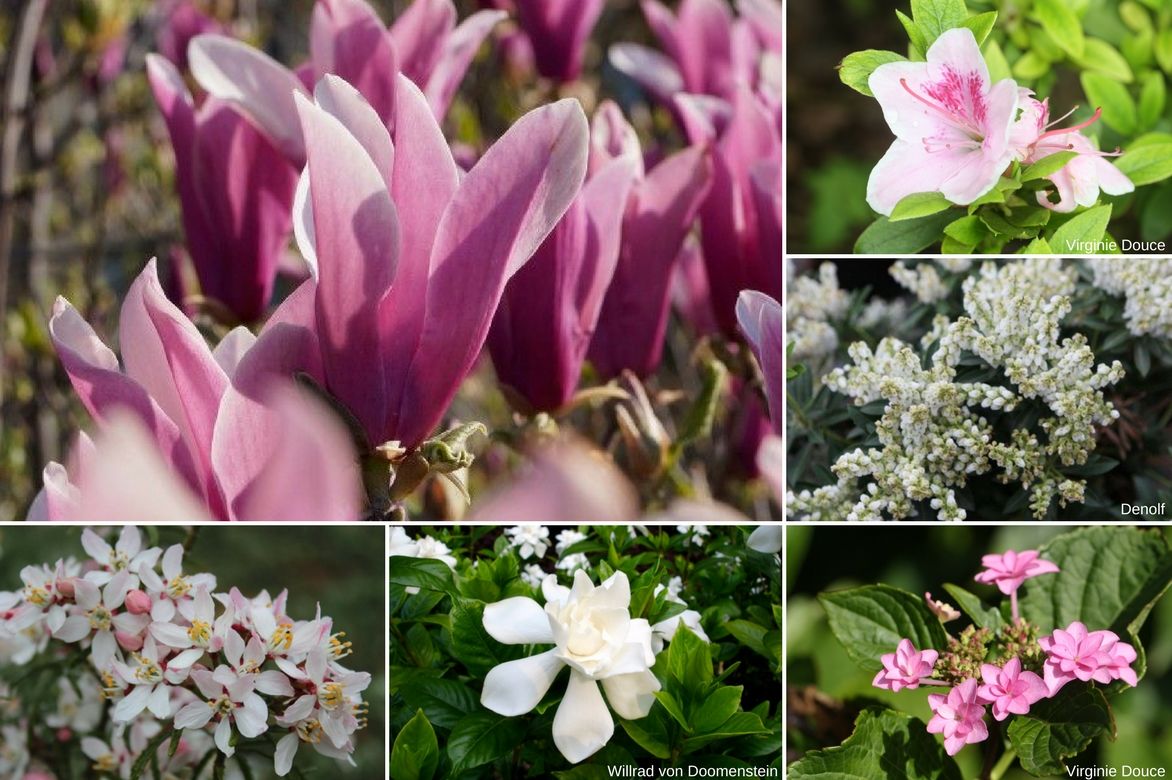
An idea for pairing in acidic soil: Azalea ‘Ho Oden’, Pieris japonica ‘Debutante’, Hydrangea macrophylla ‘Etoile Violette’, Gardenia jasminoides ‘Crown Jewel’, Choisya ‘Apple Blossom’ under the cover of a Magnolia liliflora ‘Nigra’.
Particularly floriferous, it maintains a bushy habit, with green foliage, and makes a beautiful bush for woodland edges. In a heather soil mass, it will combine well with shrubs that have complementary attributes and equally remarkable flowering, such as Rhododendrons, Pieris, Japanese Azaleas, Kalmia latifolia, or Magnolias, Mexican Orange Blossoms, Deutzia, Camellias, and Hydrangeas that will precede or take over the flowering.
The densely flowered masses of gardenia will appear lighter alongside a magnificent Japanese maple with feathery light green or dark red foliage, finely dissected. It will also be perfect mixed with less dense foliage plants such as a Summer Heather ‘Spring Torch’, ferns, and grasses.

Another idea for pairing in a shaded atmosphere: Acer palmatum ‘Dissectum’, Carex oshimensis ‘Everillo’, Gardenia jasminoides ‘Crown Jewel’, Cyrtomium fortunei var. clivicola, Calluna vulgaris ‘Spring Torch’.
If this evergreen bush allows for a touch of green in the garden during autumn and winter months, when planted at the back of a bed with other Gardenias, it will create beautiful floral compositions all summer long.
Planted in a pot, the Gardenia will be a lovely decorative subject all year round. It pairs well with the generous flowering of Camellias and Japanese Azaleas.
Useful resources
- The most beautiful outdoor gardenias are with us!
- Discover our ideas to pair gardenia
- For a fragrant garden, check out Virginie’s article: “The 10 best fragrant flowering plants”
- Advice sheet: Gardenia: how to protect it from the cold and winter it?
- Perfumer’s plants
Frequently asked questions
-
Why are the leaves of my gardenia turning yellow more and more over the past few weeks?
It is common to see the leaves of gardenia turning yellow while the veins remain green. This tropical bush requires a lot of warmth and ambient humidity to thrive, especially during its flowering period. When watering, absolutely avoid hard water, which causes the foliage to yellow and promotes the onset of chlorosis. Remove the yellow leaves, and prune the branches just above the buds.
-
Is my gardenia's brown leaves a serious issue?
If the leaves of your gardenia turn yellowish and then brown and dry out, there may be several reasons for this. The first is that your gardenia may be too exposed to direct sunlight. If possible, move it out of direct sun rays. Remove the damaged leaves and water the plant well. Its surrounding environment is likely too dry as well. In summer, regularly mist its foliage.
-
My gardenia flowers are falling and not opening, what should I do?
If the flowers fall before opening, it is likely due to a lack of moisture. Regularly shower the foliage with non-limestone water, but avoid wetting the open flowers as this would discolour them and cause brown spots on the petals.
- Subscribe!
- Contents































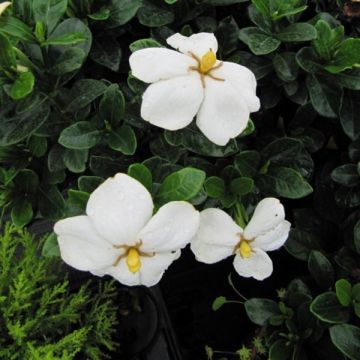

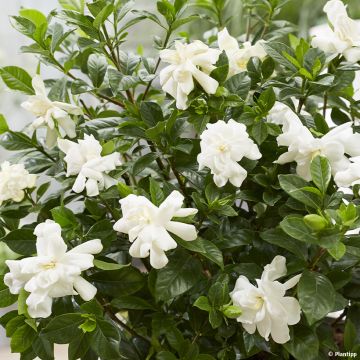

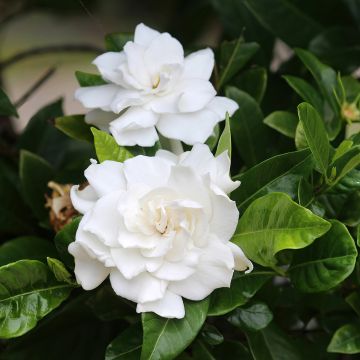

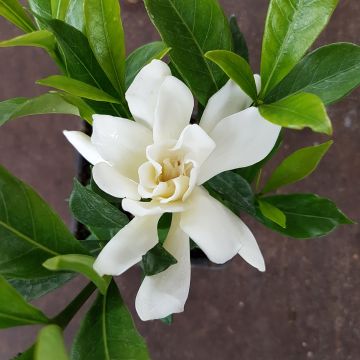
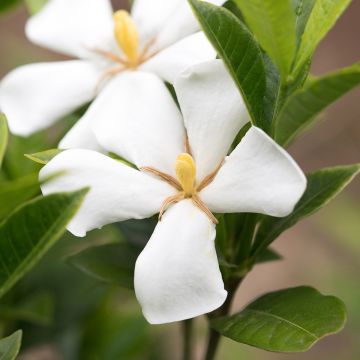
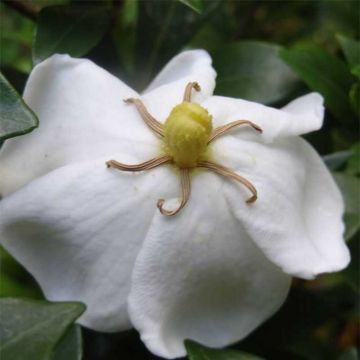

Comments